Research: Employee Satisfaction Impact on Manufacturing Productivity
VerifiedAdded on 2023/06/10
|20
|5099
|437
Report
AI Summary
This research proposal investigates the impact of employee satisfaction on organizational productivity, specifically within the manufacturing industry. It aims to identify factors driving employee satisfaction, establish the relationship between satisfaction and productivity, and address challenges faced by the manufacturing sector in achieving organizational productivity. The proposal includes a literature review covering employee satisfaction concepts, factors, and theoretical frameworks like Herzberg's Two-Factor Theory, as well as the concept of organizational productivity and strategies to enhance it. A conceptual framework is presented, and the research objectives are outlined, including highlighting key drivers, establishing relationships, identifying challenges, and recommending solutions. The study employs a mixed-method approach, utilizing surveys with 200 senior-level manufacturing employees and interviews with 4 managers. Quantitative data will be analyzed using SPSS. The research emphasizes the importance of employee motivation and a positive work environment for achieving organizational productivity.

Running head: RESEARCH PROPOSAL
Research Proposal
Topic: Impact of employee satisfaction on organisational productivity: a study based on the
manufacturing industry
Student’s name:
Name of the university:
Author’s note:
Research Proposal
Topic: Impact of employee satisfaction on organisational productivity: a study based on the
manufacturing industry
Student’s name:
Name of the university:
Author’s note:
Paraphrase This Document
Need a fresh take? Get an instant paraphrase of this document with our AI Paraphraser
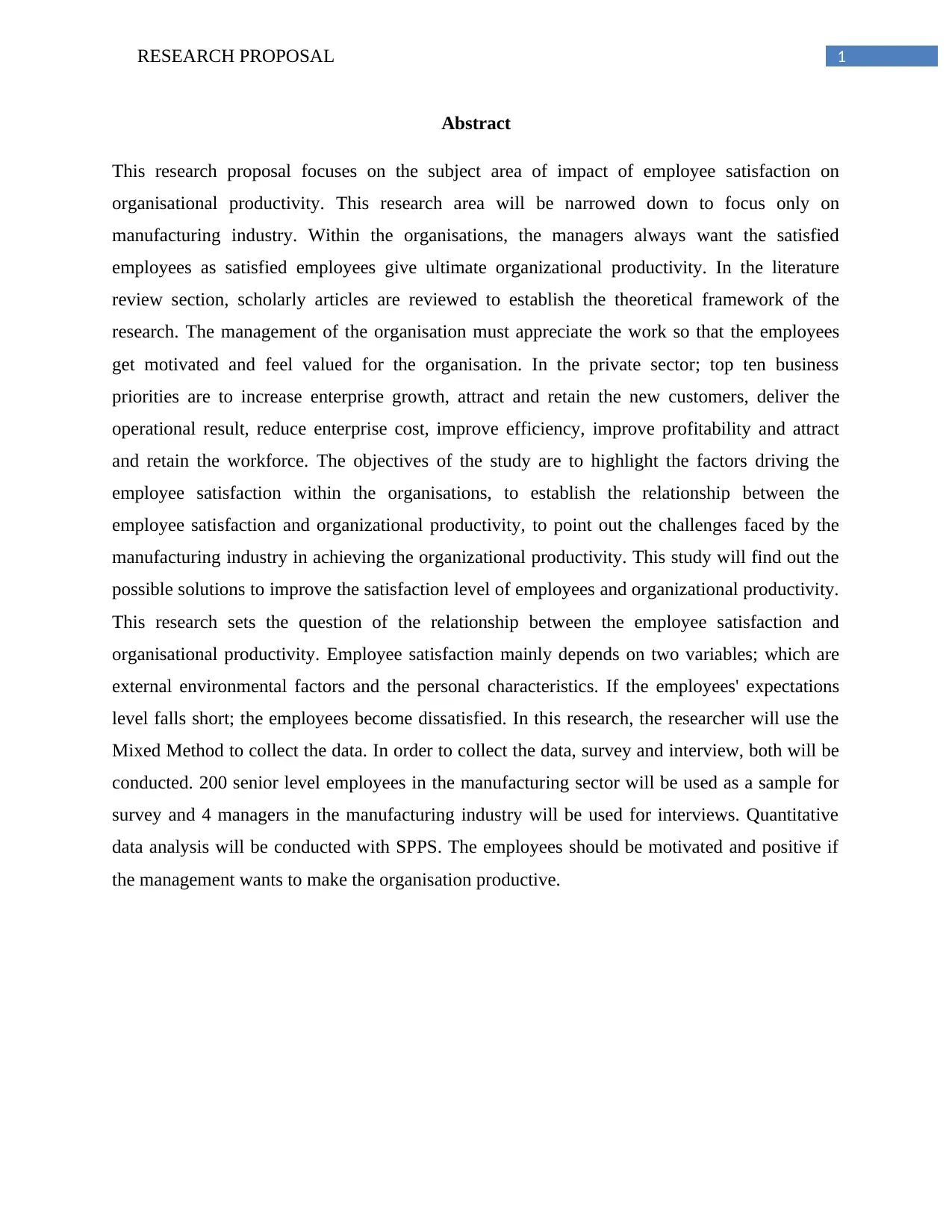
1RESEARCH PROPOSAL
Abstract
This research proposal focuses on the subject area of impact of employee satisfaction on
organisational productivity. This research area will be narrowed down to focus only on
manufacturing industry. Within the organisations, the managers always want the satisfied
employees as satisfied employees give ultimate organizational productivity. In the literature
review section, scholarly articles are reviewed to establish the theoretical framework of the
research. The management of the organisation must appreciate the work so that the employees
get motivated and feel valued for the organisation. In the private sector; top ten business
priorities are to increase enterprise growth, attract and retain the new customers, deliver the
operational result, reduce enterprise cost, improve efficiency, improve profitability and attract
and retain the workforce. The objectives of the study are to highlight the factors driving the
employee satisfaction within the organisations, to establish the relationship between the
employee satisfaction and organizational productivity, to point out the challenges faced by the
manufacturing industry in achieving the organizational productivity. This study will find out the
possible solutions to improve the satisfaction level of employees and organizational productivity.
This research sets the question of the relationship between the employee satisfaction and
organisational productivity. Employee satisfaction mainly depends on two variables; which are
external environmental factors and the personal characteristics. If the employees' expectations
level falls short; the employees become dissatisfied. In this research, the researcher will use the
Mixed Method to collect the data. In order to collect the data, survey and interview, both will be
conducted. 200 senior level employees in the manufacturing sector will be used as a sample for
survey and 4 managers in the manufacturing industry will be used for interviews. Quantitative
data analysis will be conducted with SPPS. The employees should be motivated and positive if
the management wants to make the organisation productive.
Abstract
This research proposal focuses on the subject area of impact of employee satisfaction on
organisational productivity. This research area will be narrowed down to focus only on
manufacturing industry. Within the organisations, the managers always want the satisfied
employees as satisfied employees give ultimate organizational productivity. In the literature
review section, scholarly articles are reviewed to establish the theoretical framework of the
research. The management of the organisation must appreciate the work so that the employees
get motivated and feel valued for the organisation. In the private sector; top ten business
priorities are to increase enterprise growth, attract and retain the new customers, deliver the
operational result, reduce enterprise cost, improve efficiency, improve profitability and attract
and retain the workforce. The objectives of the study are to highlight the factors driving the
employee satisfaction within the organisations, to establish the relationship between the
employee satisfaction and organizational productivity, to point out the challenges faced by the
manufacturing industry in achieving the organizational productivity. This study will find out the
possible solutions to improve the satisfaction level of employees and organizational productivity.
This research sets the question of the relationship between the employee satisfaction and
organisational productivity. Employee satisfaction mainly depends on two variables; which are
external environmental factors and the personal characteristics. If the employees' expectations
level falls short; the employees become dissatisfied. In this research, the researcher will use the
Mixed Method to collect the data. In order to collect the data, survey and interview, both will be
conducted. 200 senior level employees in the manufacturing sector will be used as a sample for
survey and 4 managers in the manufacturing industry will be used for interviews. Quantitative
data analysis will be conducted with SPPS. The employees should be motivated and positive if
the management wants to make the organisation productive.
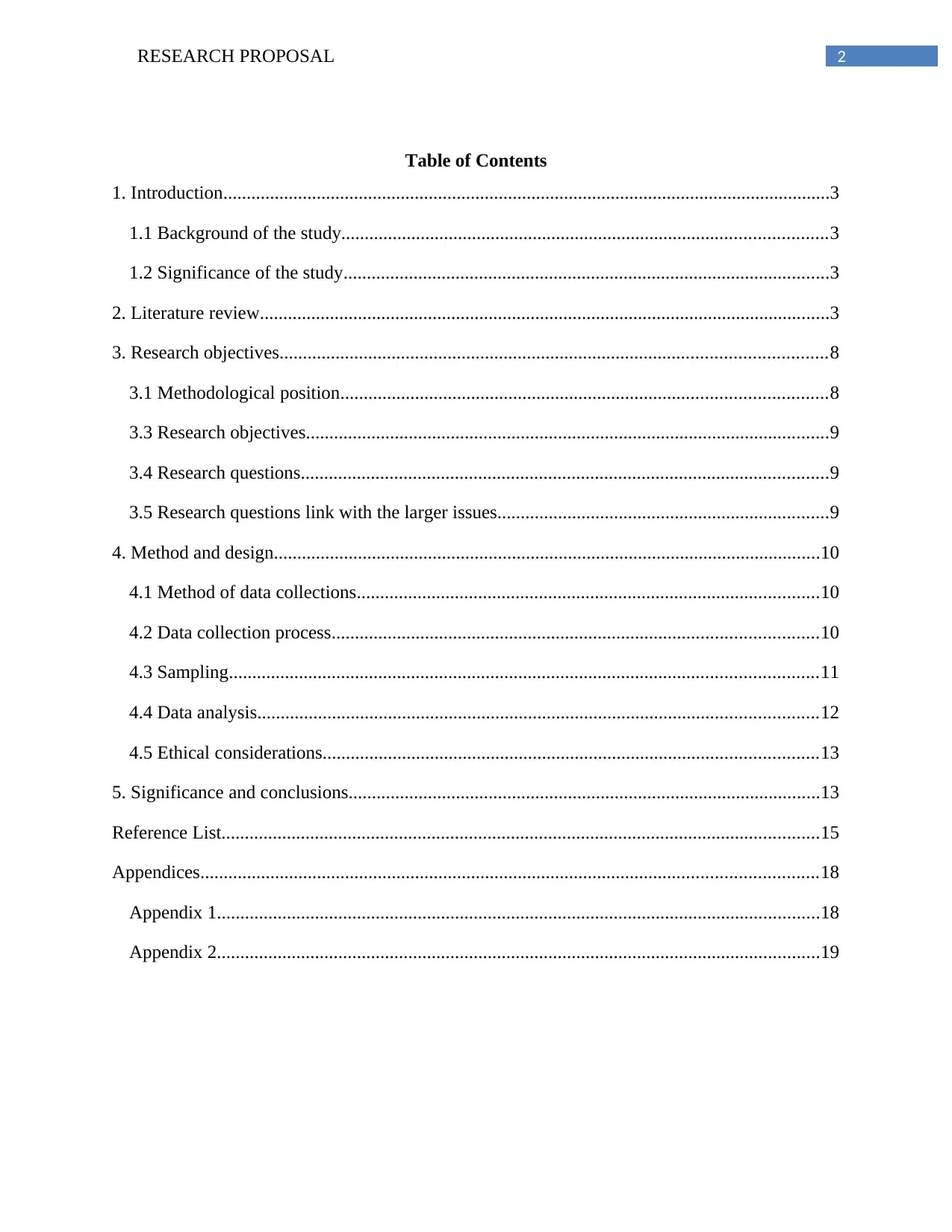
2RESEARCH PROPOSAL
Table of Contents
1. Introduction..................................................................................................................................3
1.1 Background of the study........................................................................................................3
1.2 Significance of the study........................................................................................................3
2. Literature review..........................................................................................................................3
3. Research objectives.....................................................................................................................8
3.1 Methodological position........................................................................................................8
3.3 Research objectives................................................................................................................9
3.4 Research questions.................................................................................................................9
3.5 Research questions link with the larger issues.......................................................................9
4. Method and design.....................................................................................................................10
4.1 Method of data collections...................................................................................................10
4.2 Data collection process........................................................................................................10
4.3 Sampling..............................................................................................................................11
4.4 Data analysis........................................................................................................................12
4.5 Ethical considerations..........................................................................................................13
5. Significance and conclusions.....................................................................................................13
Reference List................................................................................................................................15
Appendices....................................................................................................................................18
Appendix 1.................................................................................................................................18
Appendix 2.................................................................................................................................19
Table of Contents
1. Introduction..................................................................................................................................3
1.1 Background of the study........................................................................................................3
1.2 Significance of the study........................................................................................................3
2. Literature review..........................................................................................................................3
3. Research objectives.....................................................................................................................8
3.1 Methodological position........................................................................................................8
3.3 Research objectives................................................................................................................9
3.4 Research questions.................................................................................................................9
3.5 Research questions link with the larger issues.......................................................................9
4. Method and design.....................................................................................................................10
4.1 Method of data collections...................................................................................................10
4.2 Data collection process........................................................................................................10
4.3 Sampling..............................................................................................................................11
4.4 Data analysis........................................................................................................................12
4.5 Ethical considerations..........................................................................................................13
5. Significance and conclusions.....................................................................................................13
Reference List................................................................................................................................15
Appendices....................................................................................................................................18
Appendix 1.................................................................................................................................18
Appendix 2.................................................................................................................................19
⊘ This is a preview!⊘
Do you want full access?
Subscribe today to unlock all pages.

Trusted by 1+ million students worldwide
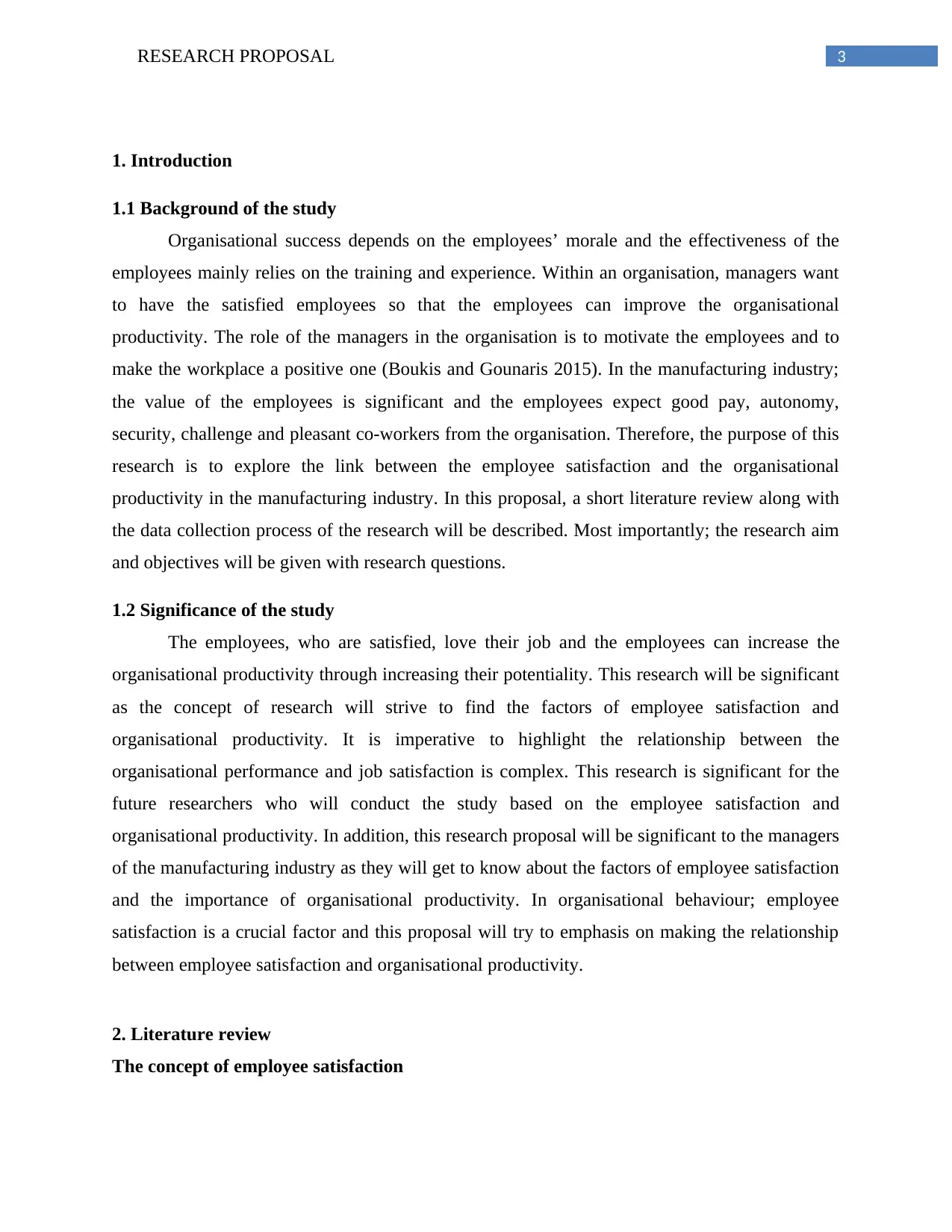
3RESEARCH PROPOSAL
1. Introduction
1.1 Background of the study
Organisational success depends on the employees’ morale and the effectiveness of the
employees mainly relies on the training and experience. Within an organisation, managers want
to have the satisfied employees so that the employees can improve the organisational
productivity. The role of the managers in the organisation is to motivate the employees and to
make the workplace a positive one (Boukis and Gounaris 2015). In the manufacturing industry;
the value of the employees is significant and the employees expect good pay, autonomy,
security, challenge and pleasant co-workers from the organisation. Therefore, the purpose of this
research is to explore the link between the employee satisfaction and the organisational
productivity in the manufacturing industry. In this proposal, a short literature review along with
the data collection process of the research will be described. Most importantly; the research aim
and objectives will be given with research questions.
1.2 Significance of the study
The employees, who are satisfied, love their job and the employees can increase the
organisational productivity through increasing their potentiality. This research will be significant
as the concept of research will strive to find the factors of employee satisfaction and
organisational productivity. It is imperative to highlight the relationship between the
organisational performance and job satisfaction is complex. This research is significant for the
future researchers who will conduct the study based on the employee satisfaction and
organisational productivity. In addition, this research proposal will be significant to the managers
of the manufacturing industry as they will get to know about the factors of employee satisfaction
and the importance of organisational productivity. In organisational behaviour; employee
satisfaction is a crucial factor and this proposal will try to emphasis on making the relationship
between employee satisfaction and organisational productivity.
2. Literature review
The concept of employee satisfaction
1. Introduction
1.1 Background of the study
Organisational success depends on the employees’ morale and the effectiveness of the
employees mainly relies on the training and experience. Within an organisation, managers want
to have the satisfied employees so that the employees can improve the organisational
productivity. The role of the managers in the organisation is to motivate the employees and to
make the workplace a positive one (Boukis and Gounaris 2015). In the manufacturing industry;
the value of the employees is significant and the employees expect good pay, autonomy,
security, challenge and pleasant co-workers from the organisation. Therefore, the purpose of this
research is to explore the link between the employee satisfaction and the organisational
productivity in the manufacturing industry. In this proposal, a short literature review along with
the data collection process of the research will be described. Most importantly; the research aim
and objectives will be given with research questions.
1.2 Significance of the study
The employees, who are satisfied, love their job and the employees can increase the
organisational productivity through increasing their potentiality. This research will be significant
as the concept of research will strive to find the factors of employee satisfaction and
organisational productivity. It is imperative to highlight the relationship between the
organisational performance and job satisfaction is complex. This research is significant for the
future researchers who will conduct the study based on the employee satisfaction and
organisational productivity. In addition, this research proposal will be significant to the managers
of the manufacturing industry as they will get to know about the factors of employee satisfaction
and the importance of organisational productivity. In organisational behaviour; employee
satisfaction is a crucial factor and this proposal will try to emphasis on making the relationship
between employee satisfaction and organisational productivity.
2. Literature review
The concept of employee satisfaction
Paraphrase This Document
Need a fresh take? Get an instant paraphrase of this document with our AI Paraphraser

4RESEARCH PROPOSAL
Managers of the organisation take strategies to fulfil the desires and needs of the
employees and the senior managers try to measure the factors of the employee satisfaction in the
workplace. If the management of the organisation is successful in providing all the needs of the
employees; the employees get satisfied. As stated by Men (2014), employee satisfaction mainly
comes from the motivation of the work, employee goal achievement and positive employee
morale in the workplace. The author further stated in his article that satisfaction of the employees
is positive for the organisation as it includes the empowering the employees and treating the
employees with respect and recognition. Moreover, according to Platis and Zoulis (2017),
employers always try to make the environment of the workplace motivated so that the employees
can work there with satisfaction. Within a manufacturing sector; the employee satisfaction is
looked at in the area of management, empowerment, teamwork, communication and co-worker
intention. The management of an organisation must focus on the job satisfaction as this can
provide the benefit of creating brand awareness, lower employee turnover, increase bottom line
profit, improve company productivity and reduce the recruitment cost.
Factors that drive employee satisfaction
According to Zhu et al. (2014), employee engagement and employee happiness is an
important matter for the modern management and low employee engagement correlates with the
decreased productivity of the organisation. The management of the organisation must appreciate
the work so that the employees get motivated and feel valued for the organisation. On the other
side, motivation and value for the organisation give the intrinsic motivation to the employees
(Cerasoli et al. 2014). The superiors must have a good relationship with the employees and
company must give the employees financial stability. In addition, the organisation must provide
flexible working hours so that the employees must get the good work-life balance. The
employees need to have a good working culture where the employees should have the good
relationship with the colleagues (Huanng et al. 2015). In the small organisations; the employees
expect to have the job security as it drives the employee satisfaction. Moreover, fixed and
attractive salary is always a motivator for the employees and interesting job content gives the
employee satisfaction.
Managers of the organisation take strategies to fulfil the desires and needs of the
employees and the senior managers try to measure the factors of the employee satisfaction in the
workplace. If the management of the organisation is successful in providing all the needs of the
employees; the employees get satisfied. As stated by Men (2014), employee satisfaction mainly
comes from the motivation of the work, employee goal achievement and positive employee
morale in the workplace. The author further stated in his article that satisfaction of the employees
is positive for the organisation as it includes the empowering the employees and treating the
employees with respect and recognition. Moreover, according to Platis and Zoulis (2017),
employers always try to make the environment of the workplace motivated so that the employees
can work there with satisfaction. Within a manufacturing sector; the employee satisfaction is
looked at in the area of management, empowerment, teamwork, communication and co-worker
intention. The management of an organisation must focus on the job satisfaction as this can
provide the benefit of creating brand awareness, lower employee turnover, increase bottom line
profit, improve company productivity and reduce the recruitment cost.
Factors that drive employee satisfaction
According to Zhu et al. (2014), employee engagement and employee happiness is an
important matter for the modern management and low employee engagement correlates with the
decreased productivity of the organisation. The management of the organisation must appreciate
the work so that the employees get motivated and feel valued for the organisation. On the other
side, motivation and value for the organisation give the intrinsic motivation to the employees
(Cerasoli et al. 2014). The superiors must have a good relationship with the employees and
company must give the employees financial stability. In addition, the organisation must provide
flexible working hours so that the employees must get the good work-life balance. The
employees need to have a good working culture where the employees should have the good
relationship with the colleagues (Huanng et al. 2015). In the small organisations; the employees
expect to have the job security as it drives the employee satisfaction. Moreover, fixed and
attractive salary is always a motivator for the employees and interesting job content gives the
employee satisfaction.

5RESEARCH PROPOSAL
Figure 1: Factors driving employee satisfaction
(Source: Huang et al. 2015)
The theoretical concept of employee satisfaction
Herzberg’s Two-Factor theory talks about improving the motivator factors to increase the
job satisfaction. Motivator factors in the workplace are the achievement, work, personal growth,
recognition and advancement; these factors help to improve the job satisfaction. In addition,
Holmberg et al. (2018) stated that Herzberg talks about improving the hygiene factors which
decreases the job dissatisfaction. Hygiene factors in the workplace are the working condition,
policies and rules, supervisor qualities and base wage and salary; in the absence of these factors;
the employees can get dissatisfied.
Figure 1: Factors driving employee satisfaction
(Source: Huang et al. 2015)
The theoretical concept of employee satisfaction
Herzberg’s Two-Factor theory talks about improving the motivator factors to increase the
job satisfaction. Motivator factors in the workplace are the achievement, work, personal growth,
recognition and advancement; these factors help to improve the job satisfaction. In addition,
Holmberg et al. (2018) stated that Herzberg talks about improving the hygiene factors which
decreases the job dissatisfaction. Hygiene factors in the workplace are the working condition,
policies and rules, supervisor qualities and base wage and salary; in the absence of these factors;
the employees can get dissatisfied.
⊘ This is a preview!⊘
Do you want full access?
Subscribe today to unlock all pages.

Trusted by 1+ million students worldwide
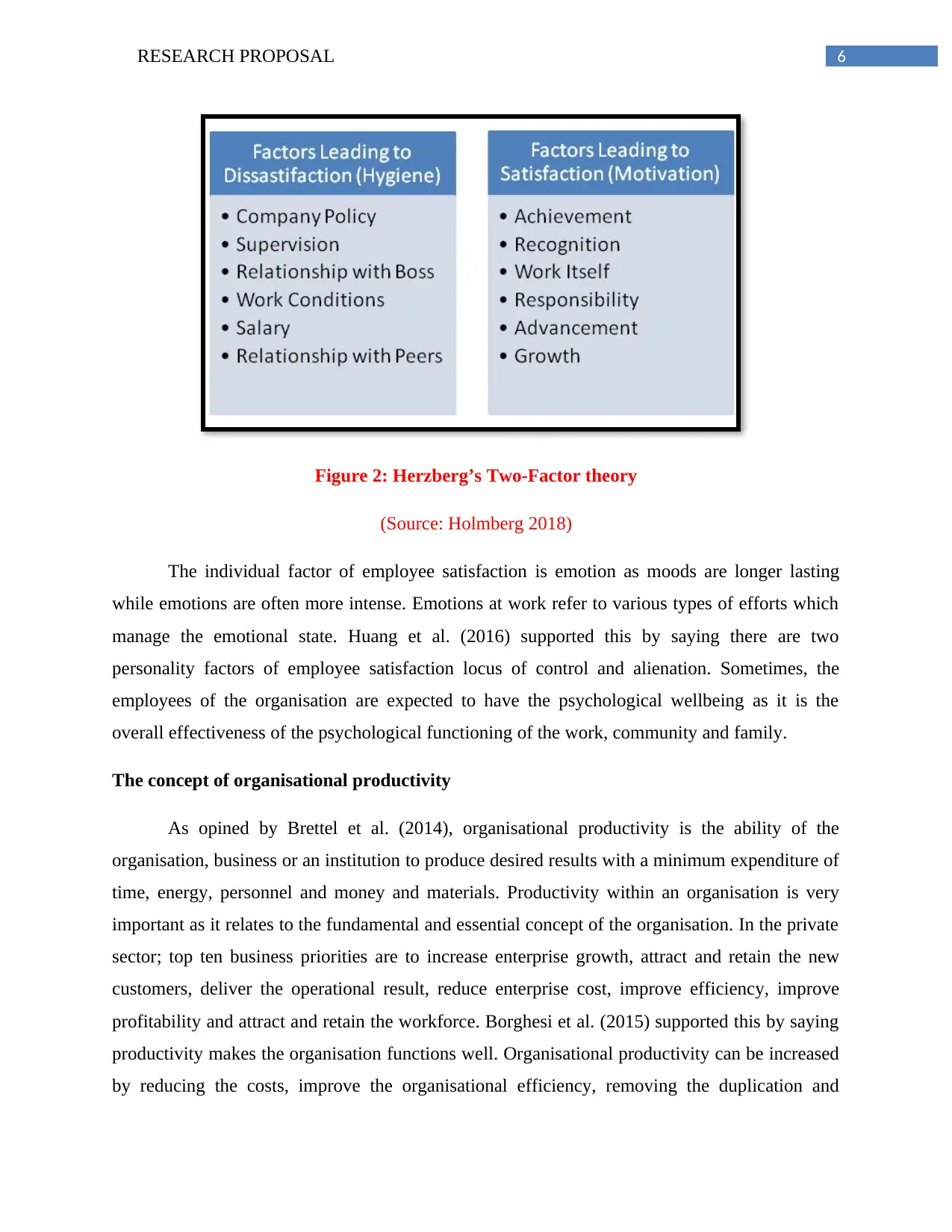
6RESEARCH PROPOSAL
Figure 2: Herzberg’s Two-Factor theory
(Source: Holmberg 2018)
The individual factor of employee satisfaction is emotion as moods are longer lasting
while emotions are often more intense. Emotions at work refer to various types of efforts which
manage the emotional state. Huang et al. (2016) supported this by saying there are two
personality factors of employee satisfaction locus of control and alienation. Sometimes, the
employees of the organisation are expected to have the psychological wellbeing as it is the
overall effectiveness of the psychological functioning of the work, community and family.
The concept of organisational productivity
As opined by Brettel et al. (2014), organisational productivity is the ability of the
organisation, business or an institution to produce desired results with a minimum expenditure of
time, energy, personnel and money and materials. Productivity within an organisation is very
important as it relates to the fundamental and essential concept of the organisation. In the private
sector; top ten business priorities are to increase enterprise growth, attract and retain the new
customers, deliver the operational result, reduce enterprise cost, improve efficiency, improve
profitability and attract and retain the workforce. Borghesi et al. (2015) supported this by saying
productivity makes the organisation functions well. Organisational productivity can be increased
by reducing the costs, improve the organisational efficiency, removing the duplication and
Figure 2: Herzberg’s Two-Factor theory
(Source: Holmberg 2018)
The individual factor of employee satisfaction is emotion as moods are longer lasting
while emotions are often more intense. Emotions at work refer to various types of efforts which
manage the emotional state. Huang et al. (2016) supported this by saying there are two
personality factors of employee satisfaction locus of control and alienation. Sometimes, the
employees of the organisation are expected to have the psychological wellbeing as it is the
overall effectiveness of the psychological functioning of the work, community and family.
The concept of organisational productivity
As opined by Brettel et al. (2014), organisational productivity is the ability of the
organisation, business or an institution to produce desired results with a minimum expenditure of
time, energy, personnel and money and materials. Productivity within an organisation is very
important as it relates to the fundamental and essential concept of the organisation. In the private
sector; top ten business priorities are to increase enterprise growth, attract and retain the new
customers, deliver the operational result, reduce enterprise cost, improve efficiency, improve
profitability and attract and retain the workforce. Borghesi et al. (2015) supported this by saying
productivity makes the organisation functions well. Organisational productivity can be increased
by reducing the costs, improve the organisational efficiency, removing the duplication and
Paraphrase This Document
Need a fresh take? Get an instant paraphrase of this document with our AI Paraphraser

7RESEARCH PROPOSAL
making more efficient delivery of the work by the employees (Lazaroiu 2015). The authors
further stated that inputs in the products are the capital assets, energy, materials and labours.
Strategies to drive organisational productivity
Bakotic (2016) stated that employees who are happy in the workplace; devote private
time to the work. The author further stated that the satisfied employees are committed and
creative in the workplace as well. The author conducted an empirical research with more than 40
Croatian companies and the author concluded that satisfied employees have extraordinary
performance. Manpower can increase the organisational productivity as the organisation can
consider the training in department wise so that the employees can meet the required skills. Most
importantly, in the manufacturing sector; the organisation needs to improve the equipment and
machines so that the productivity of the organisation can be increased. Input materials can be
increased as the organisation can use appropriate quality of materials, substitute of materials
being used. The management invests in the development of the employees as financial gain is
required. In the study of Shet et al. (2017), factors in the workplace are increased of
globalisation, shortage of skills, demanding stakeholders and diversity of the workforce, which
will help to increase the satisfaction of the employees. The authors used 272 government
workplace departments as the sample size to find out the findings.
Conceptual framework
making more efficient delivery of the work by the employees (Lazaroiu 2015). The authors
further stated that inputs in the products are the capital assets, energy, materials and labours.
Strategies to drive organisational productivity
Bakotic (2016) stated that employees who are happy in the workplace; devote private
time to the work. The author further stated that the satisfied employees are committed and
creative in the workplace as well. The author conducted an empirical research with more than 40
Croatian companies and the author concluded that satisfied employees have extraordinary
performance. Manpower can increase the organisational productivity as the organisation can
consider the training in department wise so that the employees can meet the required skills. Most
importantly, in the manufacturing sector; the organisation needs to improve the equipment and
machines so that the productivity of the organisation can be increased. Input materials can be
increased as the organisation can use appropriate quality of materials, substitute of materials
being used. The management invests in the development of the employees as financial gain is
required. In the study of Shet et al. (2017), factors in the workplace are increased of
globalisation, shortage of skills, demanding stakeholders and diversity of the workforce, which
will help to increase the satisfaction of the employees. The authors used 272 government
workplace departments as the sample size to find out the findings.
Conceptual framework
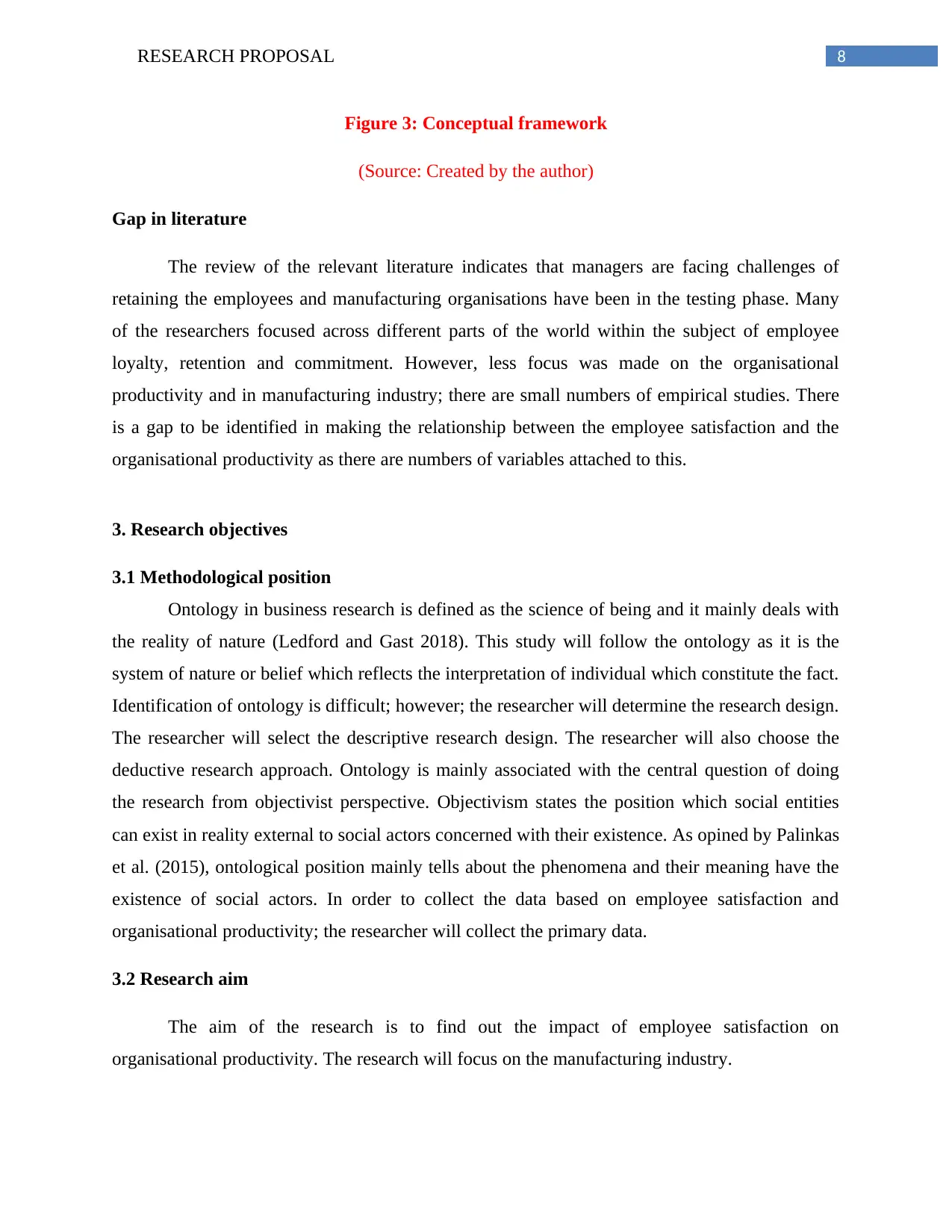
8RESEARCH PROPOSAL
Figure 3: Conceptual framework
(Source: Created by the author)
Gap in literature
The review of the relevant literature indicates that managers are facing challenges of
retaining the employees and manufacturing organisations have been in the testing phase. Many
of the researchers focused across different parts of the world within the subject of employee
loyalty, retention and commitment. However, less focus was made on the organisational
productivity and in manufacturing industry; there are small numbers of empirical studies. There
is a gap to be identified in making the relationship between the employee satisfaction and the
organisational productivity as there are numbers of variables attached to this.
3. Research objectives
3.1 Methodological position
Ontology in business research is defined as the science of being and it mainly deals with
the reality of nature (Ledford and Gast 2018). This study will follow the ontology as it is the
system of nature or belief which reflects the interpretation of individual which constitute the fact.
Identification of ontology is difficult; however; the researcher will determine the research design.
The researcher will select the descriptive research design. The researcher will also choose the
deductive research approach. Ontology is mainly associated with the central question of doing
the research from objectivist perspective. Objectivism states the position which social entities
can exist in reality external to social actors concerned with their existence. As opined by Palinkas
et al. (2015), ontological position mainly tells about the phenomena and their meaning have the
existence of social actors. In order to collect the data based on employee satisfaction and
organisational productivity; the researcher will collect the primary data.
3.2 Research aim
The aim of the research is to find out the impact of employee satisfaction on
organisational productivity. The research will focus on the manufacturing industry.
Figure 3: Conceptual framework
(Source: Created by the author)
Gap in literature
The review of the relevant literature indicates that managers are facing challenges of
retaining the employees and manufacturing organisations have been in the testing phase. Many
of the researchers focused across different parts of the world within the subject of employee
loyalty, retention and commitment. However, less focus was made on the organisational
productivity and in manufacturing industry; there are small numbers of empirical studies. There
is a gap to be identified in making the relationship between the employee satisfaction and the
organisational productivity as there are numbers of variables attached to this.
3. Research objectives
3.1 Methodological position
Ontology in business research is defined as the science of being and it mainly deals with
the reality of nature (Ledford and Gast 2018). This study will follow the ontology as it is the
system of nature or belief which reflects the interpretation of individual which constitute the fact.
Identification of ontology is difficult; however; the researcher will determine the research design.
The researcher will select the descriptive research design. The researcher will also choose the
deductive research approach. Ontology is mainly associated with the central question of doing
the research from objectivist perspective. Objectivism states the position which social entities
can exist in reality external to social actors concerned with their existence. As opined by Palinkas
et al. (2015), ontological position mainly tells about the phenomena and their meaning have the
existence of social actors. In order to collect the data based on employee satisfaction and
organisational productivity; the researcher will collect the primary data.
3.2 Research aim
The aim of the research is to find out the impact of employee satisfaction on
organisational productivity. The research will focus on the manufacturing industry.
⊘ This is a preview!⊘
Do you want full access?
Subscribe today to unlock all pages.

Trusted by 1+ million students worldwide
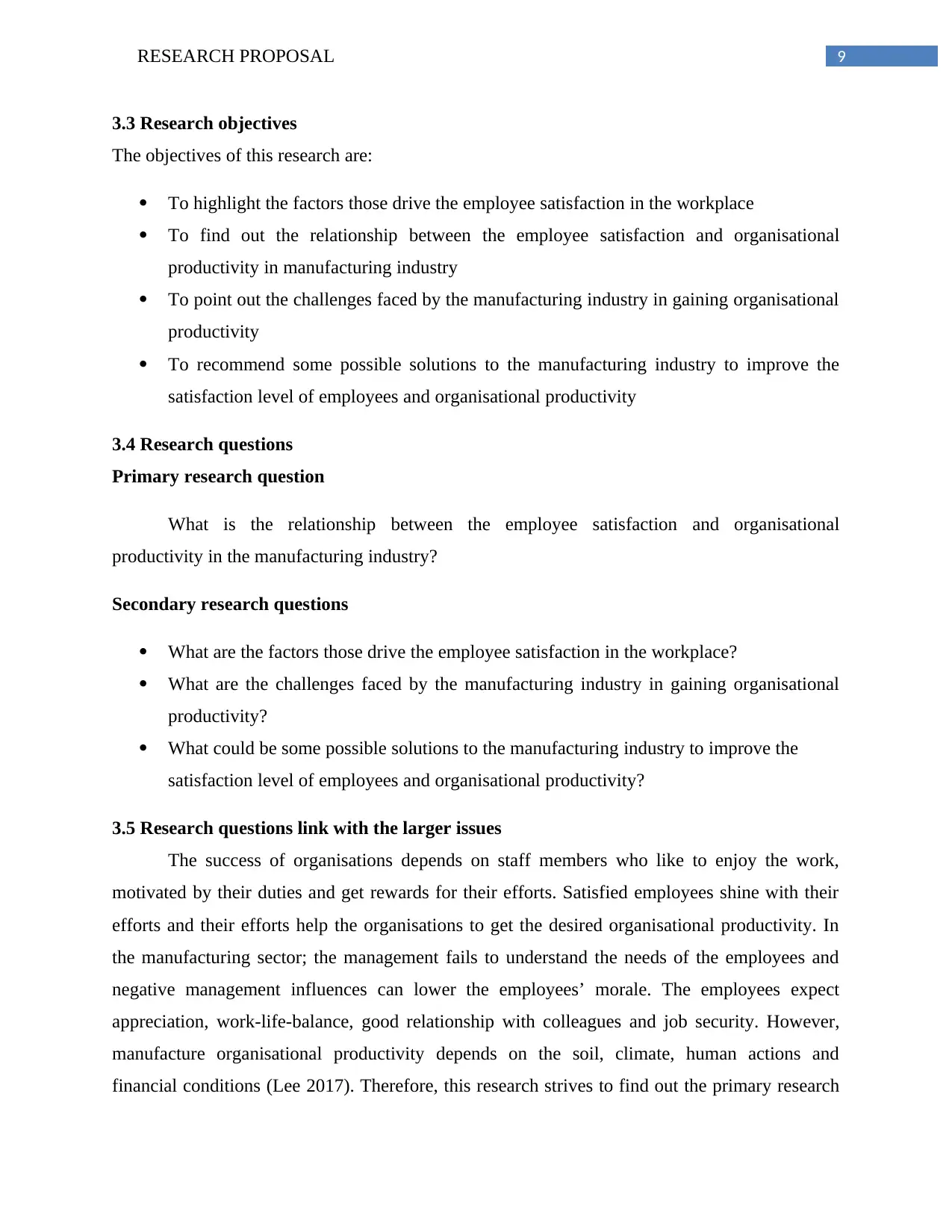
9RESEARCH PROPOSAL
3.3 Research objectives
The objectives of this research are:
To highlight the factors those drive the employee satisfaction in the workplace
To find out the relationship between the employee satisfaction and organisational
productivity in manufacturing industry
To point out the challenges faced by the manufacturing industry in gaining organisational
productivity
To recommend some possible solutions to the manufacturing industry to improve the
satisfaction level of employees and organisational productivity
3.4 Research questions
Primary research question
What is the relationship between the employee satisfaction and organisational
productivity in the manufacturing industry?
Secondary research questions
What are the factors those drive the employee satisfaction in the workplace?
What are the challenges faced by the manufacturing industry in gaining organisational
productivity?
What could be some possible solutions to the manufacturing industry to improve the
satisfaction level of employees and organisational productivity?
3.5 Research questions link with the larger issues
The success of organisations depends on staff members who like to enjoy the work,
motivated by their duties and get rewards for their efforts. Satisfied employees shine with their
efforts and their efforts help the organisations to get the desired organisational productivity. In
the manufacturing sector; the management fails to understand the needs of the employees and
negative management influences can lower the employees’ morale. The employees expect
appreciation, work-life-balance, good relationship with colleagues and job security. However,
manufacture organisational productivity depends on the soil, climate, human actions and
financial conditions (Lee 2017). Therefore, this research strives to find out the primary research
3.3 Research objectives
The objectives of this research are:
To highlight the factors those drive the employee satisfaction in the workplace
To find out the relationship between the employee satisfaction and organisational
productivity in manufacturing industry
To point out the challenges faced by the manufacturing industry in gaining organisational
productivity
To recommend some possible solutions to the manufacturing industry to improve the
satisfaction level of employees and organisational productivity
3.4 Research questions
Primary research question
What is the relationship between the employee satisfaction and organisational
productivity in the manufacturing industry?
Secondary research questions
What are the factors those drive the employee satisfaction in the workplace?
What are the challenges faced by the manufacturing industry in gaining organisational
productivity?
What could be some possible solutions to the manufacturing industry to improve the
satisfaction level of employees and organisational productivity?
3.5 Research questions link with the larger issues
The success of organisations depends on staff members who like to enjoy the work,
motivated by their duties and get rewards for their efforts. Satisfied employees shine with their
efforts and their efforts help the organisations to get the desired organisational productivity. In
the manufacturing sector; the management fails to understand the needs of the employees and
negative management influences can lower the employees’ morale. The employees expect
appreciation, work-life-balance, good relationship with colleagues and job security. However,
manufacture organisational productivity depends on the soil, climate, human actions and
financial conditions (Lee 2017). Therefore, this research strives to find out the primary research
Paraphrase This Document
Need a fresh take? Get an instant paraphrase of this document with our AI Paraphraser
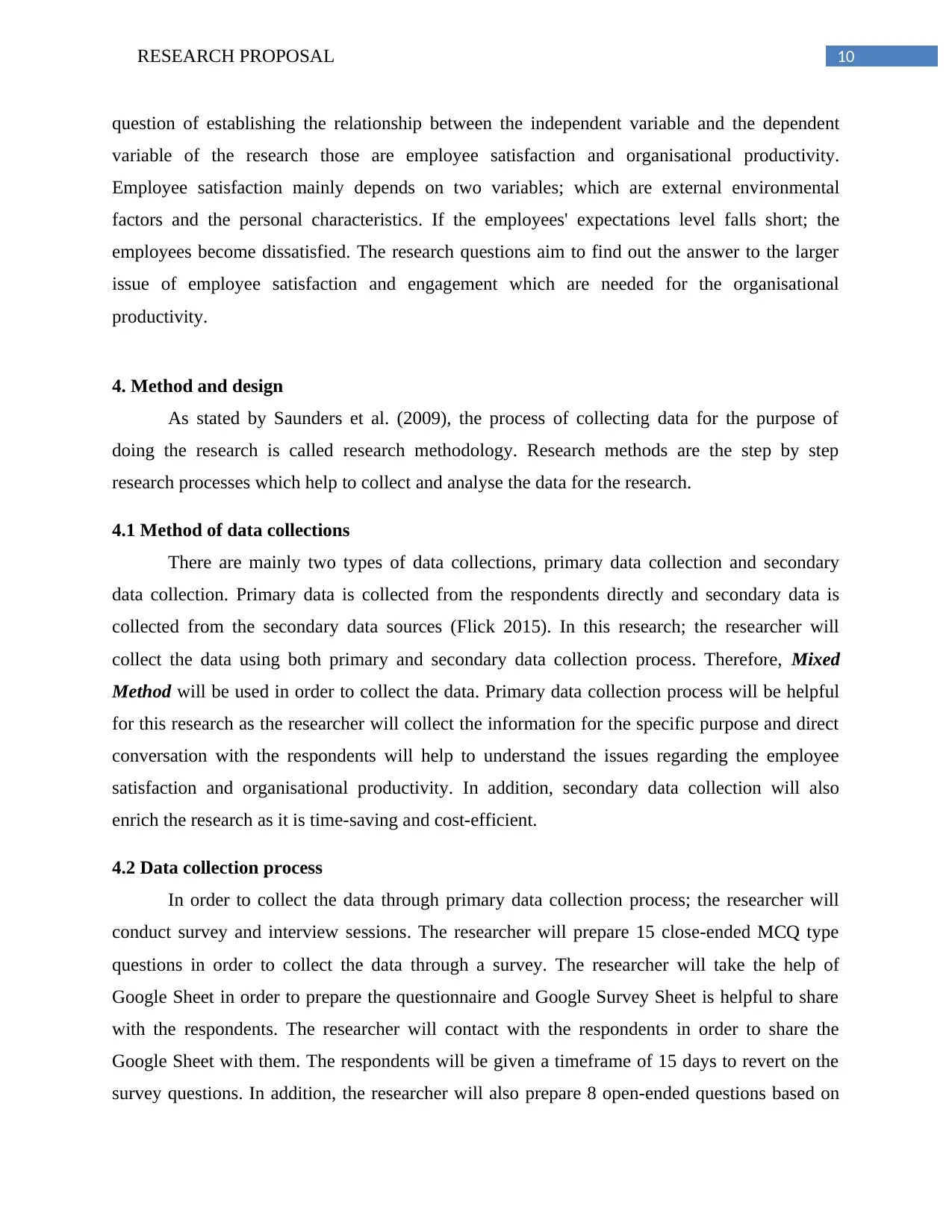
10RESEARCH PROPOSAL
question of establishing the relationship between the independent variable and the dependent
variable of the research those are employee satisfaction and organisational productivity.
Employee satisfaction mainly depends on two variables; which are external environmental
factors and the personal characteristics. If the employees' expectations level falls short; the
employees become dissatisfied. The research questions aim to find out the answer to the larger
issue of employee satisfaction and engagement which are needed for the organisational
productivity.
4. Method and design
As stated by Saunders et al. (2009), the process of collecting data for the purpose of
doing the research is called research methodology. Research methods are the step by step
research processes which help to collect and analyse the data for the research.
4.1 Method of data collections
There are mainly two types of data collections, primary data collection and secondary
data collection. Primary data is collected from the respondents directly and secondary data is
collected from the secondary data sources (Flick 2015). In this research; the researcher will
collect the data using both primary and secondary data collection process. Therefore, Mixed
Method will be used in order to collect the data. Primary data collection process will be helpful
for this research as the researcher will collect the information for the specific purpose and direct
conversation with the respondents will help to understand the issues regarding the employee
satisfaction and organisational productivity. In addition, secondary data collection will also
enrich the research as it is time-saving and cost-efficient.
4.2 Data collection process
In order to collect the data through primary data collection process; the researcher will
conduct survey and interview sessions. The researcher will prepare 15 close-ended MCQ type
questions in order to collect the data through a survey. The researcher will take the help of
Google Sheet in order to prepare the questionnaire and Google Survey Sheet is helpful to share
with the respondents. The researcher will contact with the respondents in order to share the
Google Sheet with them. The respondents will be given a timeframe of 15 days to revert on the
survey questions. In addition, the researcher will also prepare 8 open-ended questions based on
question of establishing the relationship between the independent variable and the dependent
variable of the research those are employee satisfaction and organisational productivity.
Employee satisfaction mainly depends on two variables; which are external environmental
factors and the personal characteristics. If the employees' expectations level falls short; the
employees become dissatisfied. The research questions aim to find out the answer to the larger
issue of employee satisfaction and engagement which are needed for the organisational
productivity.
4. Method and design
As stated by Saunders et al. (2009), the process of collecting data for the purpose of
doing the research is called research methodology. Research methods are the step by step
research processes which help to collect and analyse the data for the research.
4.1 Method of data collections
There are mainly two types of data collections, primary data collection and secondary
data collection. Primary data is collected from the respondents directly and secondary data is
collected from the secondary data sources (Flick 2015). In this research; the researcher will
collect the data using both primary and secondary data collection process. Therefore, Mixed
Method will be used in order to collect the data. Primary data collection process will be helpful
for this research as the researcher will collect the information for the specific purpose and direct
conversation with the respondents will help to understand the issues regarding the employee
satisfaction and organisational productivity. In addition, secondary data collection will also
enrich the research as it is time-saving and cost-efficient.
4.2 Data collection process
In order to collect the data through primary data collection process; the researcher will
conduct survey and interview sessions. The researcher will prepare 15 close-ended MCQ type
questions in order to collect the data through a survey. The researcher will take the help of
Google Sheet in order to prepare the questionnaire and Google Survey Sheet is helpful to share
with the respondents. The researcher will contact with the respondents in order to share the
Google Sheet with them. The respondents will be given a timeframe of 15 days to revert on the
survey questions. In addition, the researcher will also prepare 8 open-ended questions based on
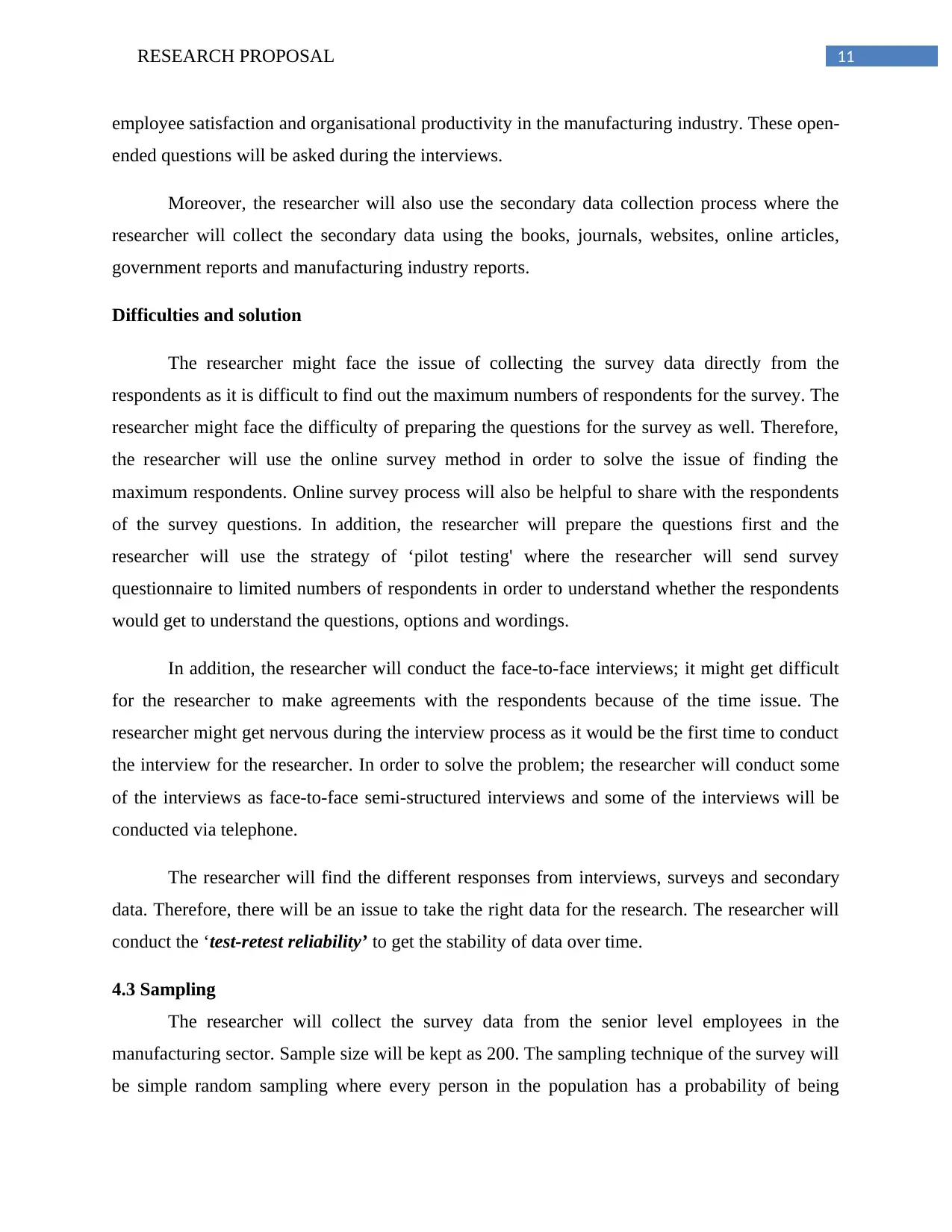
11RESEARCH PROPOSAL
employee satisfaction and organisational productivity in the manufacturing industry. These open-
ended questions will be asked during the interviews.
Moreover, the researcher will also use the secondary data collection process where the
researcher will collect the secondary data using the books, journals, websites, online articles,
government reports and manufacturing industry reports.
Difficulties and solution
The researcher might face the issue of collecting the survey data directly from the
respondents as it is difficult to find out the maximum numbers of respondents for the survey. The
researcher might face the difficulty of preparing the questions for the survey as well. Therefore,
the researcher will use the online survey method in order to solve the issue of finding the
maximum respondents. Online survey process will also be helpful to share with the respondents
of the survey questions. In addition, the researcher will prepare the questions first and the
researcher will use the strategy of ‘pilot testing' where the researcher will send survey
questionnaire to limited numbers of respondents in order to understand whether the respondents
would get to understand the questions, options and wordings.
In addition, the researcher will conduct the face-to-face interviews; it might get difficult
for the researcher to make agreements with the respondents because of the time issue. The
researcher might get nervous during the interview process as it would be the first time to conduct
the interview for the researcher. In order to solve the problem; the researcher will conduct some
of the interviews as face-to-face semi-structured interviews and some of the interviews will be
conducted via telephone.
The researcher will find the different responses from interviews, surveys and secondary
data. Therefore, there will be an issue to take the right data for the research. The researcher will
conduct the ‘test-retest reliability’ to get the stability of data over time.
4.3 Sampling
The researcher will collect the survey data from the senior level employees in the
manufacturing sector. Sample size will be kept as 200. The sampling technique of the survey will
be simple random sampling where every person in the population has a probability of being
employee satisfaction and organisational productivity in the manufacturing industry. These open-
ended questions will be asked during the interviews.
Moreover, the researcher will also use the secondary data collection process where the
researcher will collect the secondary data using the books, journals, websites, online articles,
government reports and manufacturing industry reports.
Difficulties and solution
The researcher might face the issue of collecting the survey data directly from the
respondents as it is difficult to find out the maximum numbers of respondents for the survey. The
researcher might face the difficulty of preparing the questions for the survey as well. Therefore,
the researcher will use the online survey method in order to solve the issue of finding the
maximum respondents. Online survey process will also be helpful to share with the respondents
of the survey questions. In addition, the researcher will prepare the questions first and the
researcher will use the strategy of ‘pilot testing' where the researcher will send survey
questionnaire to limited numbers of respondents in order to understand whether the respondents
would get to understand the questions, options and wordings.
In addition, the researcher will conduct the face-to-face interviews; it might get difficult
for the researcher to make agreements with the respondents because of the time issue. The
researcher might get nervous during the interview process as it would be the first time to conduct
the interview for the researcher. In order to solve the problem; the researcher will conduct some
of the interviews as face-to-face semi-structured interviews and some of the interviews will be
conducted via telephone.
The researcher will find the different responses from interviews, surveys and secondary
data. Therefore, there will be an issue to take the right data for the research. The researcher will
conduct the ‘test-retest reliability’ to get the stability of data over time.
4.3 Sampling
The researcher will collect the survey data from the senior level employees in the
manufacturing sector. Sample size will be kept as 200. The sampling technique of the survey will
be simple random sampling where every person in the population has a probability of being
⊘ This is a preview!⊘
Do you want full access?
Subscribe today to unlock all pages.

Trusted by 1+ million students worldwide
1 out of 20
Related Documents
Your All-in-One AI-Powered Toolkit for Academic Success.
+13062052269
info@desklib.com
Available 24*7 on WhatsApp / Email
![[object Object]](/_next/static/media/star-bottom.7253800d.svg)
Unlock your academic potential
Copyright © 2020–2025 A2Z Services. All Rights Reserved. Developed and managed by ZUCOL.





